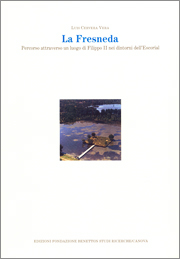
La Fresneda
Percorso attraverso un luogo di Filippo II nei dintorni dell’Escorial
by Luis Cervera Vera
preface by Domenico Luciani and presentation by Luis Cervera Miralles
with the assistance of Carmen Añón and Carmen García-Frías Checa
Fondazione Benetton Studi Ricerche-Canova
Treviso 2003
120 pages
22 illustrations in colour and 85 black and white
cover price 17 euros
ISBN 88-8409-063-6
(Memorie, 7)
[La Fresneda. A favourite place of Philip II near the Escoria]
La Fresneda, a place of woods and meadows, of pools, dams and canals, of works of architecture and achievements of gardening dates from the XVI century. And this natural and cultural treasure remains almost unknown to the scientific community and the heritage protection authorities and is bypassed entirely by the general public that flocks to Philip II’s nearby palace-monastery, the Escorial.
So, in deciding to dedicate the seventh International Carlo Scarpa Prize for Gardens to La Fresneda, the jury helped lay the basis for a campaign to attract the attention of scholars, the authorities responsible for heritage protection and the international community to the urgent need for adequate provisions to safeguard and enhance the site. And to this end the jury commissioned Luis Cervera Vera, already the author of a highly respected study of La Fresneda, to continue his research into the many, often surprising, aspects of this unique cultural landscape.
This book, which is published simultaneously in Spanish and Italian editions, is an updated account of current knowledge of the place. But the research is not finished. Like many other repositories of history and heritage, La Fresneda continues to engage our generation in studying its geography, its history, the principles that underlay its design and the ideas and talents and skills that have informed it over the centuries. For such knowledge is an essential prerequisite for responsible planning of its future.
Luis Cervera Vera
The keywords in any biography of Luis Cervera Vera are bound to include vocation, endeavour and determination.
He had a Ph.D. in Architecture and a degree in Exact Sciences, and he was also qualified in Town Planning. He was a conservation architect at the Treasury from 1951 to 1962 and 1958 saw the beginning of his important contribution as the conservation architect responsible for national monuments. His supervision of restoration work in the Cathedral, in the Colegio Mayor in Santa Cruz and in the Colegio of San Gregorio in Valladolid was much appreciated, as was his work on the walls of the Madrigal de las Altas Torres and in the Plaza Ducal of Lerma. He was a member of the Royal Academy of Fine Arts in San Fernando and of the Academy of Art and History of San Dámaso; he was also an honorary academician and correspondent member of many other academies as well as being a member of The Hispanic Society of America in New York and a correspondent member of learned societies all over the world.
As well as being a distinguished architect, Luis Cervera Vera was an important researcher. Indeed, for much of his career, especially in the later years of his life, his real vocation could be said to have been scholarship. The enduring result of this painstaking research in archives, libraries and bookshops is a body of over 200 books and articles.
The more important of these include: Resumen histórico del urbanismo, El conjunto palacial del la villa de Lerma, Sobre las ciudades ideales de Platón, Las ciudaded teóricas de Hipódamo de Mileto, Plazas Mayores de España, Documentos biográficos de Juan Herrera, Las Estampase il Sumario de El Escorial por Juan Herrera.
Contents
Un luogo, una persona, di Domenico Luciani, 9
Presentazione, di Luis Cervera Miralles, 13
I. Atlante, 17
Situazione geografica, 17
Ubicazione, 17
Dipendenza amministrativa, 20
II. Storia, 27
La fabbrica del monastero di San Lorenzo El Real dell’Escorial, 27
Filippo II conosce la Fresneda, 27
La Fresneda risulta di gradimento ai frati di san Girolamo, 28
Filippo II acquisisce la Fresneda, 29
Scrittura delle quattro parti a favore di Filippo II, 35
Filippo II dona la Fresneda al monastero di San Lorenzo, 38
Firma di Filippo II nel Privilegio, 39
III. Paesaggio, 41
Si dà inizio alla creazione della Fresneda, 41
Filippo II pianifica personalmente la trasformazione della natura intorno all’Escorial, 42
La natura urbanizzata, 44
Filippo II incarica Juan Serón della descrizione minuziosa dei terreni, 50
Pedro de Hoyo predispone la «Memoria» per Juan Serón, 50
Il lavoro di Juan Serón, 51
Discordanze tra i terreni e le loro descrizioni, 51
La recinzione del possedimento, 52
Le piantagioni, 54
Notizie sui terreni, 60
Sviluppo delle piantagioni e aumento dei terreni, 62
Nomina di Juan Bautista de Cabrera a guardia maggiore, 62
I bacini, 62
IV. Architettura, 73
Opere, norme per l’esecuzione, 73
Costruzione della «casa di Sua Maestà», 74
La«casa principale» o «casa dei frati», 79
Baltasar de Alquiza completa i lavori della «casa dei frati», 80
La «casa del progetto», 80
Le scale, 82
Le fontane e le decorazioni, 82
Le scuderie e le mangiatoie, 84
I recipienti per i fiori, 85
Benedizione della Fresneda e consegna delle reliquie, 85
Demolizione della chiesa di San Giovanni Battista, 85
Postfazioni
Il monastero reale dell’Escorial, di Carmen García-Frías Checa, 91
Profilo di Filippo II, di Carmen Añón, 97
Documenti, 105
Repertorio cronologico della bibliografia, 107
Elenco alfabetico di autori e titoli citati nel repertorio cronologico della bibliografia, 111
Abbreviazioni, 111
Indice analitico, 113
